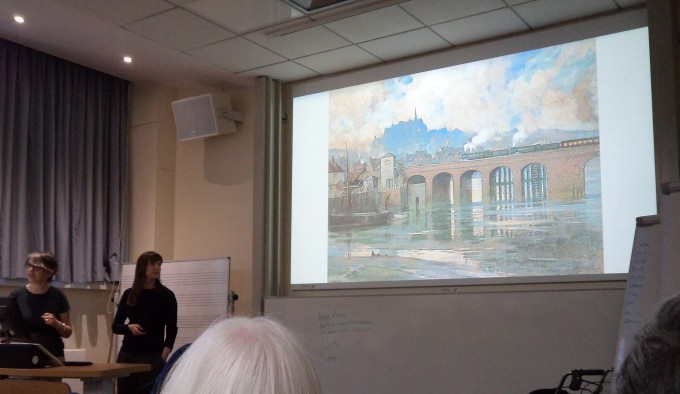I appreciate that being Sunday, the ‘Tudor and Stuart Canterbury’ conference took place yesterday, but for that report I’m afraid you are going to have to wait until later in the week because I have yet to report on two events that took place last Thursday and since then preparations for the conference have taken up all my time. The two events were the staff-postgraduate History seminar where the paper was given by Dr Suzanne Coley, and the Friends of Canterbury Archaeological Trust [FCAT] lecture on the ‘Finding Eanswythe’ project (just to add to the abundance of riches, Professor Alexandra Walsham was speaking at the Canterbury Historical Association meeting on Thursday too).
To begin with Suzanne’s paper, for most people in Canterbury Archbishop Baldwin is primarily remembered for his desire to set up a house of canons at St Stephen’s, Hackington, just to the north-east of Canterbury. This project in many ways polarised Canterbury society between Baldwin’s supporters and those who sided with the prior at Canterbury Christ Church. Nor was the dispute confined to Canterbury, as kings, bishops and the pope were drawn in as both parties sought the upper hand over the resting place of Becket’s relics. Yet, as Dr Coley showed, this was only one aspect of Baldwin of Canterbury’s life and interests, and she has been studying his anti-heretical polemical writings.
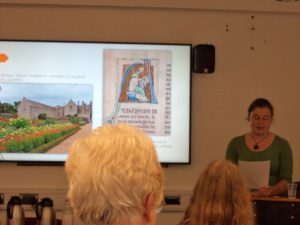
Dr Coley considers Baldwin and his abbey at Forde, Dorset
As a Devonian educated at the school at Exeter Cathedral, who then studied abroad at Bologna one of the burgeoning centres of learning, when he turned to the monastic life he chose a West Country house, the small Cistercian abbey at Forde. He rose rapidly, becoming the house’s third abbot and thereafter he was promoted higher with the Church, rising from bishop to Archbishop of Canterbury in 1185. However, it was his theological writings that Suzanne sought to highlight, and during his life he was an extremely prolific writer, including among his many works a book of sermons and his Liber de Sectis Hereticorum, which survives today as a single copy. This latter topic was one he was passionate about, that is the idea of heresy rather than the personal lives of the heretics themselves, seeing heresy as a sort-of ongoing genealogy whereby each succeeding generation drew on and grew out of what had gone before. An allied theme that he explored, and, which concerned him deeply, was the value of humility. Moreover, he saw an important connection between humility and God-given wisdom, and he also drew on two little known patristic writers of the early centuries. In addition he sought to underline the corrupting influence of pride that he saw in those teachers who made things more complex than was necessary, thereby confusing the people and potentially leading them astray. And all of this was being played out against a background of the rise of the schools of Italy and Paris, the growth in the libraries of Cistercian houses, and the ideas on one side of Bernard of Clairvaux and on the other of Peter Abelard.
Having discussed how Baldwin structured his book, which must be said sounded decidedly confusing because he was drawing on the works of his two patristic sources and seemed concerned to include just about every example even if this led to considerable duplication, Suzanne considered the dissemination of his treatise. For this she feels Peter of Blois’ Tractatus De Fide (now a Jesus College manuscript) may hold one of the keys. As the ‘borrower’ of sources, Peter is extremely handy because it is feasible to work out what he had been reading, and if he was reading Baldwin’s work, surely others were too. With this in mind, Suzanne has analysed Peter’s book in relation to Baldwin’s. She has found that in effect he condensed his source to make it more readable, and to illustrate this she provided some examples. All of this was extremely interesting both in terms of the characteristics of those seen as heretics and the somewhat more difficult problem of defining the term, and she left her audience with her conclusion about the link between heresy and the absence or limited availability of pastoral care – something that might be said to have risen to the fore in the period prior to 1215 (Fourth Lateran Council); and interestingly in England to a degree again under Archbishop Chichele in the early 15th century when he sought to improve the educational standing of the clergy.
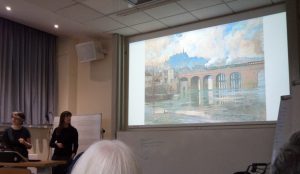
Lesley and Ellie show the coming of the railway to Folkestone.
Moving both back and forwards in time, Dr Lesley Hardy and Dr Ellie Williams brought their audience up-to-date with progress on the HLF-funded ‘Finding Eanswythe’ project they are running with Canterbury Archaeological Trust (CAT), especially Dr Andrew Richardson, in Folkestone. Lesley began by introducing the town’s modern development from the mid-19th century with the coming of the railway, and its role as a health spa, especially for those suffering from TB. She also noted the significance of the local large landholder, Earl Radnor, in such developments. However, as became clear later on, the Earl’s influence extended to the form of Anglicanism practised in the town – this influence is still clear in the architecture of the medieval and Victorian parish churches that, as at Ramsgate and Deal, can be seen to be the ‘children’ of the Oxford Movement.
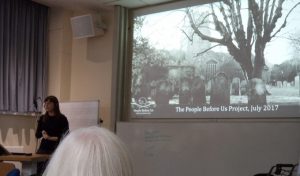
Ellie discusses the ‘People before Us’ project
However, this expansion had other repercussions including the ‘loss’ of Folkestone’s earlier history under a plethora of Victorian streets and later high-rise buildings, all of which make it very difficult for people today to understand how and even where their ancestors lived and worked. To try to bring this connection back, Ellie next outlined the part of the project known as ‘People before Us’ that last year, and again this summer will focus on the graveyard of St Mary and St Eanswythe parish church. The simple purpose of this mini-project is to survey the graveyard, including mapping the gravestones and recording their inscriptions to compare them to earlier surveys. Yet, in some ways even more importantly, this community project is by and for the people of Folkestone, as well as army veterans who are finding archaeology can be exceeding therapeutic in their adjustment to civilian life. Drawing on what happened last summer, Ellie explained that people of all ages came to find out what was going on and some stayed on – perhaps for a short time, others for the full 10 days – to get involved or to talk about their town. Thus, the graveyard was a way of opening up a dialogue with all sorts of people as individuals and as groups, such as the rough sleepers, who had claimed ‘ownership’ of the space but were happy to share it. Ellie also found changes in the responses of the local schoolchildren who went from seeing it as a dark and scary place to one that they were keen to visit to find out what had been discovered. This curiosity was shared by adults and Ellie kept a Day Book of their comments that include comments such as “empowering’’, “had a laugh”, “made new friends” and “learned new skills”. To further enhance these experiences, Lesley and Ellie ran workshops and held lectures, and the idea is to repeat these this summer, in addition to the project’s ongoing series of talks, the graveyard and church becoming ‘therapeutic landscapes’ for as many people as possible.
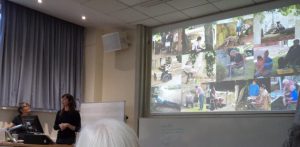
Some of the people who took part in the project last summer.
Lesley then took over for the final section of the lecture to talk about Eanswythe, focusing on ideas about memory and place as exemplified through relics and reliquaries. She discussed the role of the dead in Jewish, Roman and Christian traditions, as well as the move to the veneration of saints, something foreign to the Romans but widely embraced by the Christian world – church buildings reflecting the proximity of earth and heaven, the secular and the sacred, the living and the dead. Moving on, she considered the relationship between Christianity and royal power, which is exemplified by the early post-Roman kingdom of Kent of the 6th to 8th centuries where a high proportion of its princesses, and even queens, became abbesses of the many monastic houses in the county, of which the house at Folkestone was one. Founded at some point between 635 and 664, Eanswythe, as the granddaughter of King Ethelbert who had welcomed Augustine in 597, was ideal to be abbess there. The house’s position on a hill above the sea was equally ideal – its church could act as a seamark, yet it was sufficiently remote potentially to act as a reminder of the early desert fathers who had sought to leave civilisation for the contemplative life of the monastery.
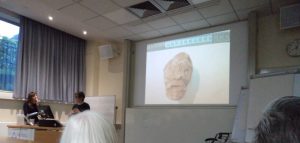
Ellie and Leslie consider one of the surviving carved stones
Furthermore, many of these royal abbesses from Kent would be venerated as saints, and saints brought relics and miracles, as well as giving the person in question an afterlife through memory and commemoration, which for Eanswythe might be seen as exemplified by the ‘reliquary’ rediscovered in the late 19th century – featured in the 1885 volume of Archaeologia Cantiana (the journal of the Kent Archaeological Society). For, even though at present all that is known for sure is that the bones in the casket are those of a single individual – a young woman, the potential remains to uncover what Eanswythe has meant to the townspeople of Folkestone over the centuries. This research is currently ongoing and may include the carbon dating of the bones. Yet even if that doesn’t take place, this object can, through the richness of material culture studies and the sense of place and space, act as a catalyst for this project that will also include an investigation of the ‘miracle of the stream that runs up hill’- an exploration of the Pent Stream and the possibility of Anglo-Saxon borrowings of Roman water course technology.
Thus, this project is extremely exciting and if you want to attend the next free public lecture, it will be taking place on Thursday 17 May at 6.45pm in the History Resource Centre, Folkestone Library. There you will be able to hear Sue Brunning, Curator at the British Museum, who will be speaking on ‘Respect your elders: old swords in early Anglo-Saxon England’. Sue will be using colourful art, haunting poems and fascinating swords from Kentish graves to explore why “older was always better when it came to these weapons”. If this sounds interesting, do go along you will be most welcome.
 Centre for Kent History and Heritage
Centre for Kent History and Heritage Sheila Sweetinburgh
Sheila Sweetinburgh 1382
1382